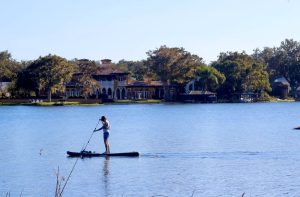The Everglades is a unique treasure to the ecological community of southern Florida. There is nothing like seeing an American alligator rest on the grassland banks while a snowy egret wades a mere 10 feet away. The sun begins to set, peeking out between the tall, skinny pine trees, casting an orange glow across the cypress knees and cabbage palms that scatter the damp ground. The animal and plant life that call this huge wetland area home are exotic and specific to Florida; no other place combines the subtropical climate, broad yet shallow river basin, and stunning biodiversity together the way this fragile ecosystem does. The 734 square miles of Everglades are home to the highest concentrations of species at risk of extinction. As the Everglades continue to be surrounded by development and starved of its natural watershed, not only the organisms within the community suffer but Florida’s economy as well.
On Thursday, Oct. 27, Rollins was lucky enough to be the second stop of a group of individuals advocating for awareness of the Everglades Restoration Project. A coach bus filled with 10 members of the Everglades Foundation and their belongings began a 12-day journey across Florida, starting in Miami and zigzagging across the state to end in Islamorada. This “Road Trip to Restoration” hopes to speed up the process of restoring this national park by highlighting the urgency of protecting these areas by explaining the political and social underpinnings of executing the current plan. By bringing the interactive info-session directly to the people, citizens of the state of Florida would have no choice but to open their eyes to the issue at hand: 1.5 billion gallons of polluted water are unnaturally gushing into Floridian waters while ultimately starving the Everglades of the freshwater flow it needs to survive.
The boundaries of Orlando serve as the starting point for water traveling down through the watershed and eventually into the Everglades ecosystem—the Kissimmee chain of lakes leads to the Kissimmee river which flows south into the swampy region. Just south of Orlando is Lake Okeechobee, which used to naturally overflow downwards towards the Everglades as well and fed a shallow sheet that continually dispersed around all of Southwest Florida. Instead, in the 1920s the Herbert Hoover Dyke was constructed, completely altering the natural flow of the lake.
North and South of Lake Okeechobee are huge agricultural areas, which insisted the dyke be built to prevent mass flooding of the lands. To nature’s dismay, it now causes the water to flow east and west into coastal lakes and rivers. However, the water being dumped east and west is incredibly polluted, so much so that Lake Okeechobee and the surrounding areas have been placed under a State of Emergency since Jan. 2016.
The excess nutrients of fertilizer runoff from the surrounding agricultural areas have caused a “guacamole thick” layer of algae and sludge to form on top of not only Lake Okeechobee but also the coastal waters fed west by the Caloosahatchee River and east by the St. Lucie River. In 2016 alone, 44 locations were confirmed as affected by this algae bloom. The smell, sight, and overall aura surrounding this toxic bloom has killed marine life and the tourist industry of these areas. Real estate values have plummeted, fishing has been dramatically reduced, and the physical and economic health of citizens continues to suffer.
The natural downward flow of water used to recharge the aquifers that provide drinking water to millions. The Everglades wetland system is unable to store and cleanse water to sustain itself and the aquifers because it is unavailable. 50% of the Everglades has been lost, whether it is from desiccation or development, and as it continues to disappear, so will Florida citizens’ drinking water.
In 2015, 6 million people in Southeastern Florida experienced conditions that were considered “severe” and “extreme” drought when graded by the National Drought Mitigation Center. Lack of freshwater to the Florida Bay made it twice as salty as the ocean, killing 50,000 acres of seagrass. Not only is this water crisis affecting the entire marine and land-based environment of Florida, but it is also lowering the quality of life for our own people.
By purchasing the agricultural land south of Lake Okeechobee, the Everglades Foundation hopes to restore the natural water flow to the Everglades. The money is available thanks to Amendment 1 in 2014, which dedicated excess revenue from real estate to land and water conservation. The federal government agreed to a 50/50 contribution—for every $1 Florida spends on restoration, the officials in Washington, D.C. will also contribute $1. We need to stop shortchanging our water supply by dumping polluted water east and west and begin this restoration project as soon as possible.
In the upcoming election, make sure you take the time to support candidates who support the Everglades. No matter what party they support, anyone who is in favor of protecting our sensitive estuary areas and understand the importance of national parks is in favor of a brighter future.












Be First to Comment